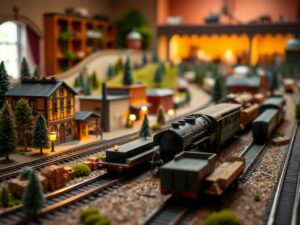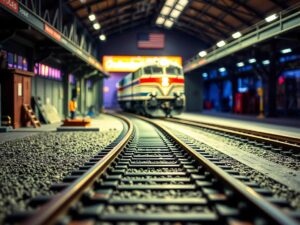
Understanding DCC Sound and Lighting for HO Scale Trains
Understanding DCC Sound & Lighting for HO Scale Trains
Welcome to the fascinating world of HO scale model railroading! You’ve probably spent hours admiring the intricate details, imagining journeys across miniature landscapes. Now, imagine adding another layer of realism â bringing those trains to life with sound and vibrant lighting. This isn’t science fiction; it’s a reality achievable with Digital Command Control (DCC) technology, specifically tailored for HO scale.
Today, we’ll explore the world of DCC sound and lighting, guiding you through its intricacies from fundamental concepts to advanced customization options.
Part 1: The Basics – What is DCC?
Imagine a conductor directing traffic with hand signals; that’s essentially how traditional model railroads operated using manual controls. Enter DCC, a digital system akin to a conductor managing each train individually, sending precise instructions via unique code for speed, direction, and other functionalities.
Think of it like an electric bus stop, but instead of numbers for your bus line, you have codes for individual locomotives or rolling stock. A central controller interprets these codes and delivers specific commands to the appropriate unit.
DCC’s major advantages include:
- Individual Control: Each train operates independently, allowing seamless coordination even with complex setups.
- Variable Speed Control: Smooth acceleration and deceleration, mimicking real-world locomotives.
- Multi-Unit Operation: Several locomotives can work together seamlessly, forming realistic consists (a grouping of trains).
- Dynamic Brake Simulations: Realistic sound effects for stopping like actual brakes, adding immersion to your layout.
- Expansion: Add features gradually â start with simple command and progressively add sound or lighting as you progress.
Part 2: Sound – A World of Realism
DCC sound brings a whole new dimension to model railroading, transforming it from silent visuals to captivating sonic landscapes.
Here’s how it works:
- Sound Modules: Compact, dedicated devices packed with pre-recorded audio files, steam whistle blasts, diesel chugging, horn sounds, and even realistic ambient effects like the clatter of rails or announcements in bustling stations.
- Integration: Sound modules plug into your chosen HO scale locomotives, typically replacing an existing speaker or fitting alongside it.
- Sound Activation: Through DCC control, you can activate specific sound files depending on throttle settings â idling engine sounds for low speed, powerful blasts for full acceleration, and quieter ambient noises for slower journeys.
Part 3: Lighting – Illuminating Your Layout
Bringing your HO scale trains to life visually is just as important as auditory realism. DCC lighting offers a multitude of possibilities:
- Internal Lights: Some locomotives are pre-equipped with LED headlights and cab lights. With DCC, you can control their intensity and flashing patterns realistically, headlights dimming when approaching signals, or strobing warning beacons during emergencies.
- Dynamic Lighting Effects: Advanced sound decoders often incorporate sophisticated lighting programs, simulating realistic flickering lantern effects on freight cars, directional headlight variations for passenger engines, and even animated flashing beacon sequences for passing train visibility.
Part 4: DCC System Essentials
Let’s break down the fundamental components you’ll need to embark on your DCC journey with HO scale trains:
- DCC Command Station: The heart of your system, it sends out signals, manages communication between your track and locomotives, and provides control for sound, lighting, and speed adjustments. Popular brands include Digitrax, ESU, and Atlas.
- Power Supply: Delivers electricity to your layout, typically rated at 18V or more depending on the scale of your track. Make sure it’s compatible with your DCC command station.
- Track Circuitry: This involves arranging your track segments strategically, enabling your DCC command station to divide them into specific sections for control. The standard is HO scale rails, which you can acquire in various forms – flexible roadbed with track already laid out or individual rail pieces for more customized setups.
Part 5: Exploring Advanced Techniques
- Sound Customization: Some systems allow fine-tuning pre-recorded sounds, adjusting the volume of horns, engine noise variations based on speed, or even adding personalized audio effects for a unique touch.
- Lighting Functions: Control different lighting schemes, from static white LEDs to intricate multicolor combinations for signals and trackside buildings, creating an engaging visual experience.
- Programmer: Use this tool (often included with the command station) to access detailed programming features, adjust sound parameters, define individual locomotive personalities, or set up automatic actions for realistic simulations.
Final Thoughts – Your HO Scale Journey Begins!
The world of DCC sound and lighting opens up endless possibilities for bringing your HO scale model railroad to life with unparalleled realism. It might seem overwhelming at first, but take it one step at a time, start by learning the basics of DCC operation, explore various sound modules, experiment with lighting effects, and gradually build upon your skills.
Remember, this is a journey of discovery and passion. Share your experiences, ask questions, and learn from fellow enthusiasts. Join our community, where you’ll find invaluable advice, inspiring layouts, and a vibrant network of hobbyists eager to help you achieve your modeling dreams!








